5 Levels Of Electrification In Cars - With Examples
The evolution of automotive technology introduced us to several forms of electric cars, each with its unique capabilities and considerations. This article aims to explain these categories, discussing their merits and potential drawbacks of each type of electrified powertrain starting with level 0 — no electrification.
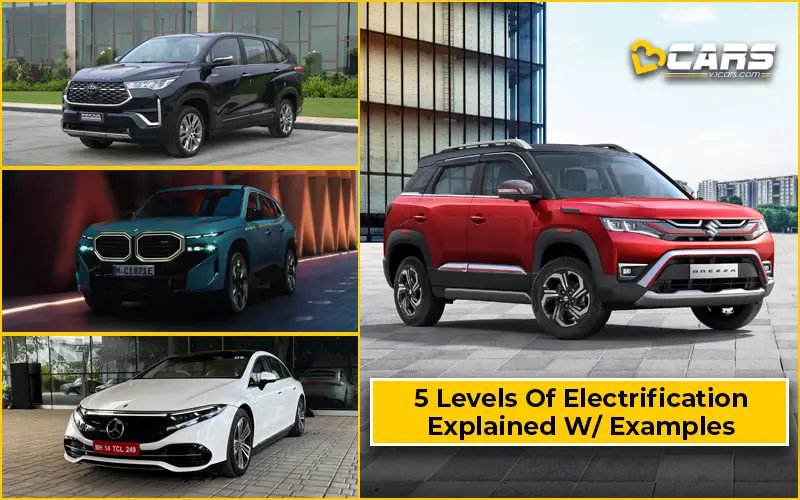
Level 0. Petrol/Diesel/CNG/LPG Car
The cars with this level of electrification are all around us — like Mahindra Scorpio N, Hyundai Verna and Maruti Suzuki Alto K10.
No Electric Assist: Traditional petrol, diesel or compressed natural gas (CNG) cars drive only on an internal combustion engine (ICE). These vehicles do not have electric assist features, meaning there's no electric motor to supplement the engine's power.
No Battery: These cars are devoid of a dedicated battery pack meant for propulsion. Although they have a small 12-volt battery for starting the engine and powering auxiliary systems like lights and infotainment, this doesn't contribute to the vehicle's drive.
No Electric Motor: Without an electric motor, these cars rely solely on the combustion of fossil fuels to generate power and move the vehicle. This setup translates to the production of more tailpipe emissions compared to their electric and electrified counterparts.
Highest Fuel Cost Per KM: The absence of electric assistance makes these vehicles the least fuel-efficient compared to all the other electrified vehicle types in this article. The cost per kilometer for petrol, diesel, or CNG vehicles is typically higher than electrified cars with comparable size and performance figures.
Available With Manual And Automatic Transmission: Traditional ICE vehicles come with both manual and automatic transmission options, offering a choice for those who enjoy the engagement of shifting gears manually. Cars like the Kia Carens even have the option of an auto-clutch manual transmission for an engaging driving experience while offering the convenience of 2-pedal driving in stop-and-go traffic.
Also Read: Hyundai Verna Turbo Petrol Drive Review - Performance
Hyundai Verna Normal Petrol Drive Review - Interior, Exterior, Performance
Maruti Suzuki Alto K10 Petrol, CNG Variants Explained - Which One To Buy?
Note: Check your Car EMI with our - Car Loan EMI Calculator
Level 1 - Mild Hybrid
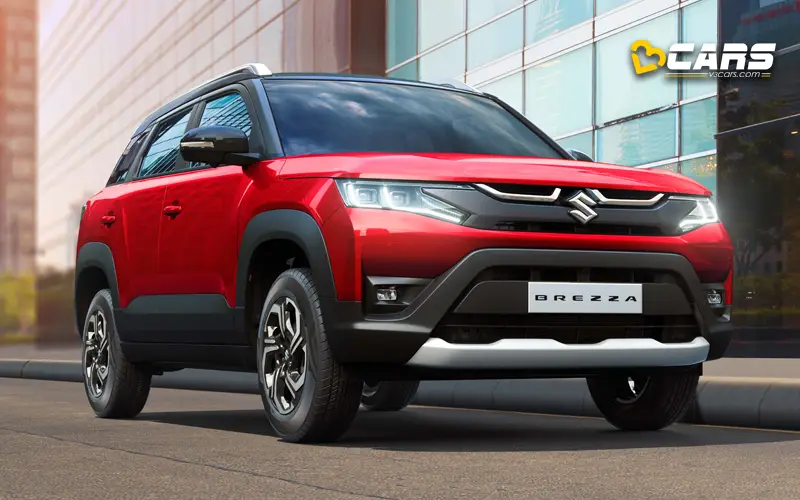
Notable examples of a mild-hybrid car are Maruti Suzuki Grand Vitara, Nexa Fronx turbo petrol, XL6, Ertiga and Brezza.
Small Battery: Mild hybrids are a step towards electrification. These vehicles have a small battery, typically with a 48-volt system, to store energy generated during deceleration and braking, known as regenerative braking.
Small Electric Motor To Assist The Engine At Low RPMs: The stored energy powers a small electric motor that assists the engine at low RPMs, typically during start-stop city driving. This can improve fuel efficiency and reduce emissions.
Slightly Better Fuel Efficiency: The electric assist provides a mild boost in fuel efficiency compared to non-hybrid vehicles, particularly in stop-and-start traffic where the electric motor eliminates the need to rev the engine harder for the desired acceleration.
Still, Fairly High Fuel Cost Per KM: While the fuel cost per kilometer is lower than traditional ICE vehicles, it's still relatively high compared to other types of electric cars. This is because the engine does most of the propulsion work.
Never Runs on Electric Motor Alone: The electric motor in a mild hybrid is not powerful enough to propel the car on its own. It merely supplements the engine, providing assistance during acceleration. So, they don’t offer the option of a smooth and silent driving experience like a proper battery electric vehicle (BEV).
Available with Manual and Automatic Transmission: Like traditional cars, mild hybrids are also available with both manual and automatic transmissions.
Also Read: Maruti Suzuki Fronx Petrol Variants Explained - Which One To Buy?
Maruti Nexa Fronx Turbo Petrol First Drive Review - Performance, Mileage
Level 2 - Hybrid (Or Strong Hybrid)
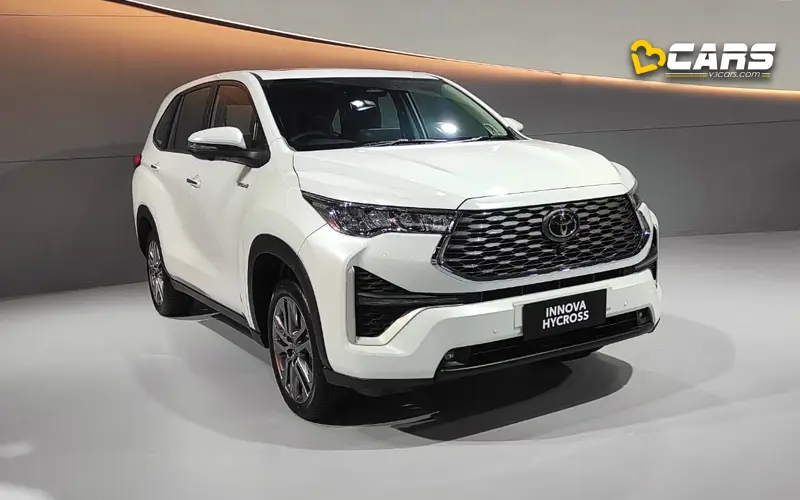
Strong hybrid cars are becoming more accessible in recent years. Cars like the Honda City, Maruti Grand Vitara, Hyryder, Innova Hycross and Toyota Camry have a hybrid powertrain as an option.
Bigger Battery: Full hybrids come with a larger battery pack than mild hybrids. This allows them to store more energy and provide more significant electric assistance to the engine.
Assists Engine To Offer Additional Torque When Needed: The more substantial electric motor in a hybrid can assist the engine in providing additional torque when necessary. This comes in handy during high-demand situations like quick acceleration or hill climbing.
Bigger Electric Motor: The larger electric motor with a bigger battery pack is what actually allows a strong hybrid car to run without burning a drop of fuel — well, at least for short distances.
Can Also Run Exclusively On Electric Motor For Short Distances (City + Hwys): Hybrids can switch to electric-only mode, allowing them to operate without the engine in certain conditions, such as low-speed city driving or short bursts on the highway. This contributes to better fuel efficiency and lower emissions.
Considerably Lower Fuel Costs Than Mild Hybrid: Because of the vehicle’s ability to drive only on an electric motor, these cars burn much less fuel and recharge the battery while the vehicle is running on fuel. Thus, they cost much less to run than mild hybrids.
No Manual Transmission Option: Due to the complex nature of the hybrid drivetrain, which involves seamless switching between the engine and electric motor, hybrids don’t come with a manual transmission.
Also Read: Toyota Innova Hycross Petrol Variants Explained - Which One To Buy?
Maruti Suzuki Grand Vitara Petrol Variants Explained - Which One To Buy?
Level 3 - Plug-In Hybrid
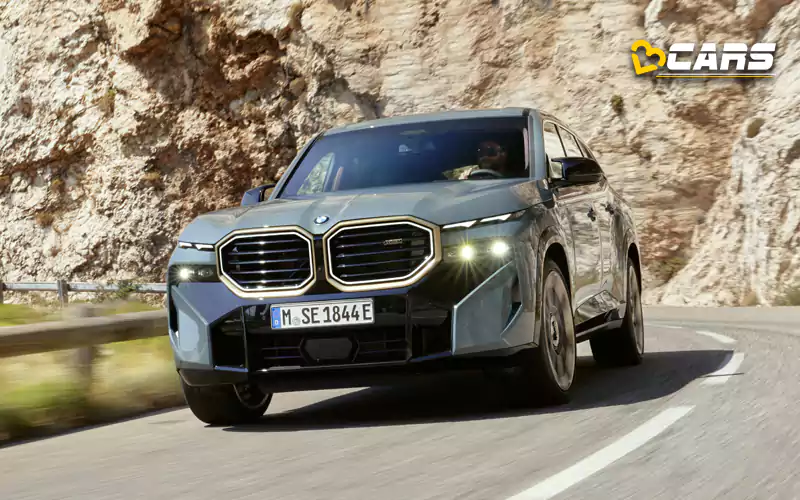
In India, the most notable car with a plug-in hybrid is the BMW XM. It has an electric range of 88km (claimed) and costs Rs. 2.60 crore (ex-showroom). In the international markets, the Prius Prime variant from Toyota is a very recognizable car with a plug-in hybrid powertrain.
Can Run Exclusively On Electric Motor Typically For 30 - 50km: Plug-in hybrids (PHEVs) come with a larger battery, which we can charge from a dedicated wall AC or DC charger. This allows them to run on electric mode for longer distances. Once this battery runs out, a plug-in hybrid can turn on the engine to propel the car and charge the battery simultaneously.
Assists Engine To Offer Additional Torque When Needed: Like regular hybrids, PHEVs can use the electric motor to assist the engine, providing additional torque when running in hybrid mode.
Provides Satisfactory Electric Performance: With both an engine and a substantial electric motor, PHEVs offer satisfactory performance for both city and highway driving even when running in EV mode.
Can Be Used As EV For Substantial Distances: If your daily commute falls within the electric range of the PHEV, you can use it as a pure electric vehicle, charging it overnight. Meanwhile, the option of a secondary powertrain can remain on standby to manage the range anxiety.
No Range Anxiety: The presence of an engine ensures that you can continue driving even when the battery depletes, eliminating range anxiety associated with pure electric cars. The battery can recharge as you drive and the car switches to electric mode again once the batteries have sufficient charge.
Even Lower Fuel Costs Than Hybrids: Since these cars can cover the daily driving duties for most car owners on EV-only mode, they work pretty much like an EV for the most part. Thus, they have very low fuel costs that are almost on par with a full EV. However, there’s no running away from the maintenance aspect of the vehicle as it has a full-fledged engine, which requires timely upkeep.
Also Read: 2023 BMW XM SUV Launched In India At Rs. 2.60 Crore
Level 4 - Battery EV
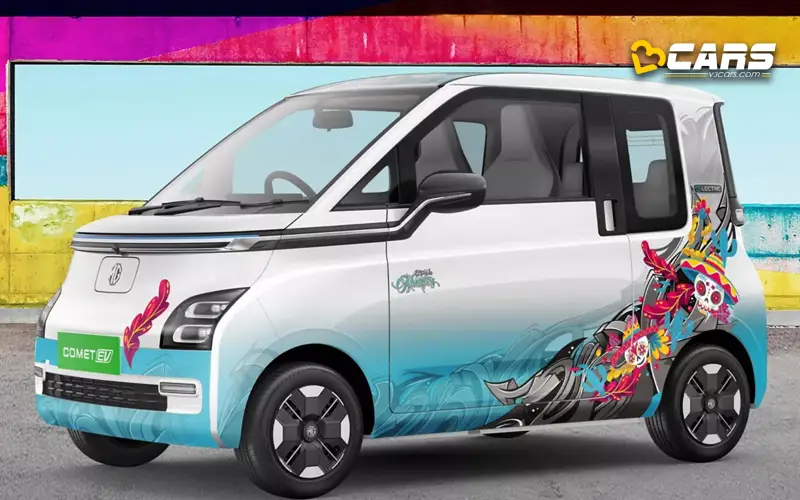
Electric cars are fairly easy to recognise as they are gaining popularity in India. On the budget side, you have options like the MG Comet, Tata Tiago EV. Slightly higher up in the price band, you have cars like the Mahindra XUV400, Tata Nexon EV (Prime and Max). As you move higher along the price scale, there are cars like the MG ZS, BYD Atto 3, Hyundai Ioniq 5 and Kia EV6. Among luxury car brands, you have options like the Mercedes EQB, EQC, EQS, BMW i4, Volvo XC40 Recharge, Audi E-Tron, Jaguar I-Pace and Porsche Taycan.
Can't Run On Fossil Fuel: Battery Electric Vehicles (BEVs), or simply electric cars, run exclusively on electricity. They have no engine or fuel tank, and thus can't run on fossil fuels.
Electric Driving Range Distance Drastically Varies: The driving range of BEVs varies significantly depending on factors like weather, driving style, tire pressure and alignment. Use of heating or air conditioning, for instance, can also reduce the range.
Needs Very Long Charging Times: Charging a BEV with a regular AC charger can take many hours, making it less convenient than a quick stop at a petrol station. Fast DC chargers can charge BEVs much quicker than AC chargers, but the time it takes is still considerably longer than refueling a petrol or diesel vehicle.
Range Anxiety Limits Your Stress-free Impromptu Drives: The limited range and longer refueling times of BEVs can lead to range anxiety, especially for long, unplanned trips. Even if there are some charging options, long road trips require some planning to align restroom stops, meals and charging breaks for the most time-efficient driving experience.
No Manual Transmission Option: Like strong hybrids and PHEVs, BEVs typically come with automatic transmissions due to the nature of electric drivetrains. Even the EVs that have multi-speed transmissions only get an automatic transmission. So, there’s no room to enjoy rowing through the gears like a full-manual shifter if you’re directly buying a car from a reputable manufacturer.
Also Read: Tata Electric Cars In India - Launched & Upcoming Models
Mahindra Showcase 5 New Electric SUVs, 2 New Electric Sub-Brands Launched
MG Comet EV First Drive Review - Range, Space, Features, Exterior, Interior
Level 5 - Range Extender EV
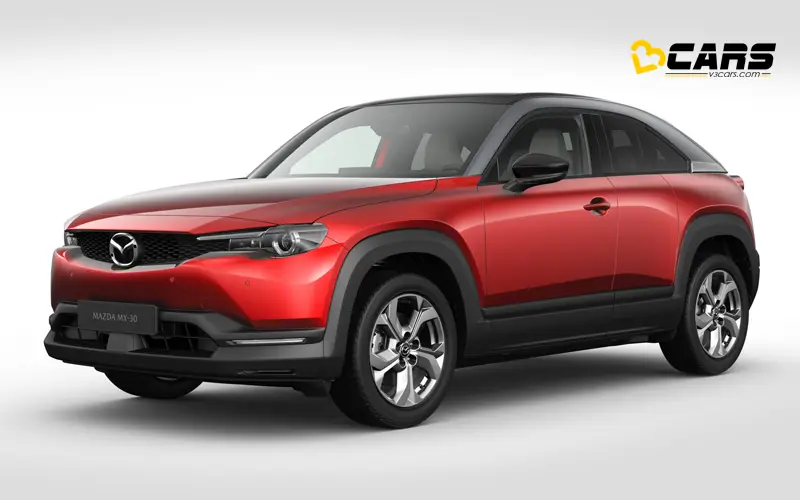
Range extender EVs aren’t available in India. However, in international markets, we have had the Chevrolet Volt and BMW i3. Mazda MX30 with a rotary engine to charge the batteries on the go is another example of a modern range extender electric car.
Drives Exclusively On Electric Motor For Highway As Well As City Driving: Range extender EVs, also known as extended-range electric vehicles (EREVs), can drive exclusively on the electric motor, whether on the highway or in the city.
Has Slightly Smaller Battery Than EVs: It has an engine to recharge the battery during longer drives. Range extender electric cars have a slightly smaller battery than pure battery electric EVs as they also have an engine that acts as a generator to charge the battery on long drives. If you have the time and find a charging station, you can also use it for a quick refill. After all, not using the on-board engine to charge the battery will save you a good deal in fuel costs.
Electric Driving Range Distance Drastically Varies: Like BEVs, the electric driving range of range extender EVs can vary significantly depending on various factors such as weather, driving style, tire pressure and alignment.
Needs Very Long Charging Times with Regular AC Charger: Range extender EVs also require long charging times with regular AC chargers, similar to pure EVs.
Can Recharge On The Go Using On-Board Generator: The key feature of extended-range EVs is their ability to recharge the battery on the go using an auxiliary petrol engine. This means you can continue driving even if the battery depletes, eliminating range anxiety.
No Manual Transmission Option: Like other electrified vehicles, range extender EVs typically come with automatic transmissions due to the nature of their drivetrains.
Note: Check your car’s fuel cost with Fuel Cost Calculator in India



0 Comments
Maruti Suzuki Cars in India
Celerio
₹5.37 - ₹7.05 lakh*
*Ex-showroom priceEeco
₹5.32 - ₹6.79 lakh*
*Ex-showroom pricetest
₹10.00 lakh*
*Ex-showroom priceDzire
₹6.79 - ₹10.14 lakh*
*Ex-showroom priceSwift
₹6.49 - ₹9.64 lakh*
*Ex-showroom priceAlto K10
₹3.99 - ₹5.96 lakh*
*Ex-showroom priceS-Presso
₹4.27 - ₹6.12 lakh*
*Ex-showroom priceBrezza
₹8.34 - ₹13.98 lakh*
*Ex-showroom priceErtiga
₹8.69 - ₹13.03 lakh*
*Ex-showroom priceWagon R
₹5.55 - ₹7.21 lakh*
*Ex-showroom priceCelerio
₹5.37 - ₹7.05 lakh*
*Ex-showroom priceEeco
₹5.32 - ₹6.79 lakh*
*Ex-showroom pricetest
₹10.00 lakh*
*Ex-showroom priceDzire
₹6.79 - ₹10.14 lakh*
*Ex-showroom priceSwift
₹6.49 - ₹9.64 lakh*
*Ex-showroom priceAlto K10
₹3.99 - ₹5.96 lakh*
*Ex-showroom priceUpcoming Maruti Suzuki Cars
Swift Hybrid
₹10.00 - ₹13.00 lakh*
*Expected PriceExpected Launch Jun 2027
WagonR EV
₹10.00 - ₹13.00 lakh*
*Expected PriceExpected Launch Oct 2027
Alto-Sized EV
₹10.00 - ₹14.00 lakh*
*Expected PriceExpected Launch Sep 2028
Brezza Matte
₹8.00 - ₹14.00 lakh*
*Expected PriceExpected Launch Oct 2025
XL5
₹8.00 - ₹12.00 lakh*
*Expected PriceExpected Launch Jun 2026
Hustler EV
₹7.00 - ₹10.00 lakh*
*Expected PriceExpected Launch Jun 2026
WagonR Flex
₹7.00 - ₹10.00 lakh*
*Expected PriceExpected Launch Jan 2027
Solio
₹5.50 - ₹7.50 lakh*
*Expected PriceExpected Launch May 2027
Swift Hybrid
₹10.00 - ₹13.00 lakh*
*Expected PriceExpected Launch Jun 2027
WagonR EV
₹10.00 - ₹13.00 lakh*
*Expected PriceExpected Launch Oct 2027
Alto-Sized EV
₹10.00 - ₹14.00 lakh*
*Expected PriceExpected Launch Sep 2028
Brezza Matte
₹8.00 - ₹14.00 lakh*
*Expected PriceExpected Launch Oct 2025
XL5
₹8.00 - ₹12.00 lakh*
*Expected PriceExpected Launch Jun 2026
Hustler EV
₹7.00 - ₹10.00 lakh*
*Expected PriceExpected Launch Jun 2026
Latest Maruti Suzuki Cars Videos
2023 Maruti Suzuki Invicto Walkaround | Differences Over Innova Hycross
Maruti Suzuki Fronx | Auto Expo 2023 | Exterior, Interior, Engine & Dimensions
Maruti Suzuki Jimny | Auto Expo 2023 | Exterior, Interior, Engine & Dimensions
Maruti Suzuki e Vitara Walkaround Review | Exterior, Interior & Specifications | Auto Expo 2025
MG Astor Select vs Maruti Suzuki Brezza ZXI+ | Which Car Is More Value For Money?
Delhi-Jaipur-Delhi in less than ₹500/person! | Long Drive in Maruti Suzuki Invicto Hybrid
Mahindra XUV 3XO AX7 vs Maruti Suzuki Brezza ZXI+ | Which Is More Value For Money Under Rs 13 Lakh?
MG Astor Sprint vs Maruti Suzuki Grand Vitara Sigma | Which Car Is More Value For Money? | Mar 2024
Maruti Suzuki Invicto Alpha+ vs Toyota Hycross Hybrid ZX | Which One To Buy?
Maruti Suzuki Invicto Petrol Hybrid Variants Explained | Zeta+ Alpha+ | Jul 2023 | V3Cars
2023 Maruti Suzuki Invicto Walkaround | Differences Over Innova Hycross
Maruti Suzuki Fronx | Auto Expo 2023 | Exterior, Interior, Engine & Dimensions
Maruti Suzuki Jimny | Auto Expo 2023 | Exterior, Interior, Engine & Dimensions
Maruti Suzuki e Vitara Walkaround Review | Exterior, Interior & Specifications | Auto Expo 2025
MG Astor Select vs Maruti Suzuki Brezza ZXI+ | Which Car Is More Value For Money?
Delhi-Jaipur-Delhi in less than ₹500/person! | Long Drive in Maruti Suzuki Invicto Hybrid
Brezza Important Links